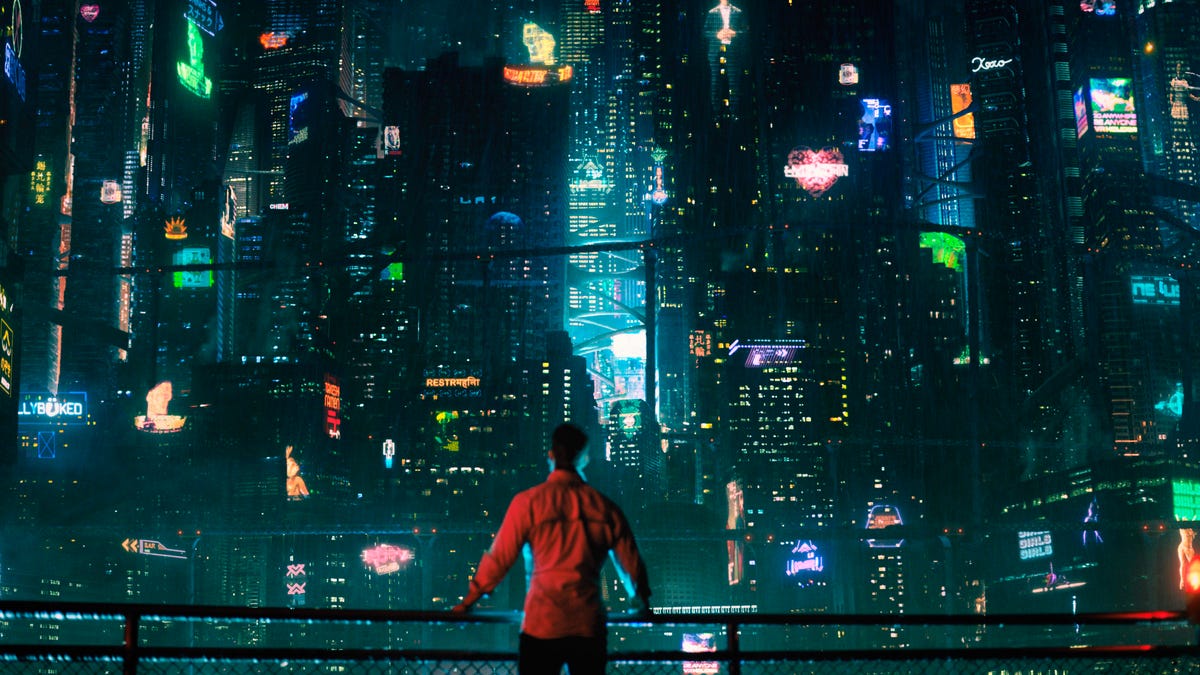Netflix's Altered Carbon was too weird for this world and that's a tragedy
Commentary: The body-hopping sci-fi thriller might have just been too weird and cerebral for Netflix audiences.

Slick sci-fi is the order of the day in Altered Carbon, a neon-drenched Netflix adaptation of the novel by Richard K. Morgan.
As a fan of weird and wacky sci-fi TV shows, I'm used to having my hopes dashed by sudden network cancelations. Heck, I'm still not over Firefly never getting a second season. So when news hit on Wednesday that Netflix canceled the mind-bending sci-fi thriller Altered Carbon, I was sad, but not shocked.
Whenever I would attempt to explain Altered Carbon to friends, they would respond with perplexed expressions as if to say, "This sounds like a lot of work." They're not wrong. I have notes on random sheets of paper I scribbled while watching, just to stay on top of who's who and what they were doing in the show.
The world of Altered Carbon (based on the novel of the same name) is a mix of weird science and personal identity issues. A person's memories and consciousness can be stored in an alien-engineered disk called a cortical stack, which is then implanted into the back of a person's neck.
Stacks can also be transplanted into new human bodies called sleeves. A person's consciousness can live forever as long as it moves from sleeve to sleeve. But if your stack is destroyed, you die. Only the wealthy, known as Meths, can afford stacks and the new human sleeves to place them in.
This body-swapping explores the idea of identity on multiple levels. Some people decide to swap genders and can split their consciousness into two sleeves rather than one. Those are the basics to Altered Carbon, but even that can be hard to follow.
Actor Joel Kinnaman as mercenary Takeshi Kovacs in season one of Altered Carbon.
In season 1, the consciousness of mercenary Takeshi Kovacs (played by Joel Kinnaman for now) is downloaded into a new body, with the task of finding the killer of a murdered Meth. He's also got to figure out clues to his own past involving his sister Reileen Kawahara (Dichen Lachman).
Season 2 jumps 30 years into the future and now Kovacs (a new sleeve brought to life by Avengers alumni Anthony Mackie) is determined to find his lost love and revolutionary leader Quellcrist Falconer (Renee Elise Goldsberry). Falconer also happens to be the original creator of the stacks and sleeves.
The second season had plenty of twists and turns that kept the story interesting and perplexing. Recruited to work on a planet called Harlan's World, Kovacs discovers Falconer is really the host for an extraterrestrial entity known as an Elder, who wants revenge on the Founders who originally took over Harlan's World. These Founders wanted to eradicate the other Elders and steal the technology behind the stacks. Still with me?
Avengers actor Anthony Mackie plays mercenary Takeshi Kovacs in season two of the Netflix sci-fi series Altered Carbon.
The remaining Elder uses Falconer's sleeve to get close enough to murder the remaining Founders. But right as the Elder decides to kill everyone (Founders and humans alike), Kovacs takes the Elder into his own stack and lets the uber-laser energy weapon destroy both him and the Elder in order to save the human race. Now that both Kovacs' sleeve and his stack are destroyed, he's dead, right? But he's not. So yeah, then things get even weirder and more confusing.
And herein lies the problem with Altered Carbon. As you can already tell, the storyline has a lot of characters who switch bodies and then try to kill each other off, then switch bodies again. This might be too complex for most run-of-the-mill sci-fi fans.
I love my sci-fi shows to have many layers, but in the case of Altered Carbon, the layers have layers and then those layers switch layers. I had a full-on detective's murder wall of notes I'd written, just so I could remember who died and who was resurrected into which person.
I'm the type of fan who likes to put the work into understanding a show better. I get obsessed over multi-faceted characters, parallel plot devices, and hard-to-grasp futuristic science. I love a TV series like Altered Carbon that doesn't spoonfeed everything to its viewers. But if you want to understand the world of Altered Carbon, you have to work at it.
Maybe that's ultimately what killed this show in the end. Attention spans are getting shorter and shorter. Superhero movies and TV shows reign over streaming. A lot of sci-fi entertainment has been whittled down to bite-sized, easy-to-comprehend stories full of relatable characters with a large dollop of nostalgia.
If Altered Carbon was about a group of kids from the '80s jumping in and out of bodies, or maybe about a bunch of superheroes who could take over a body to defeat it, maybe Netflix would be more apt to keep the show in its lineup. But there's something innately difficult about Altered Carbon for most mainstream audiences that probably kept it from becoming a runaway hit.
Altered Carbon was cyberpunk fiction at its best, with stunning graphics and special effects. But at the end of the day, if not enough people can relate to the characters and the story, it's as dead as a destroyed human memory stack. And that's a real shame.

